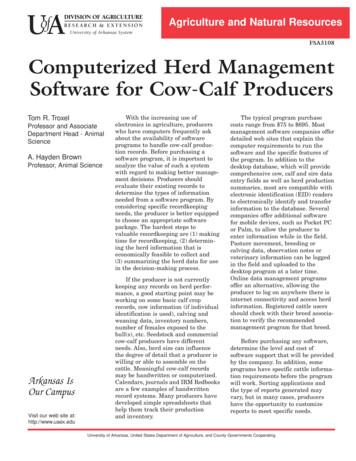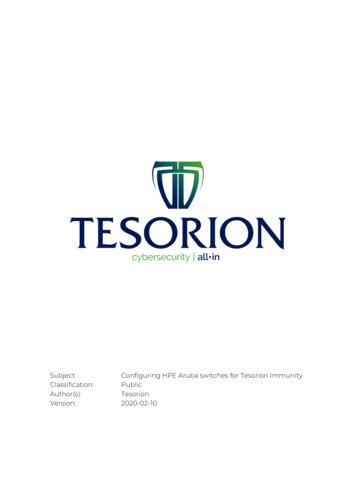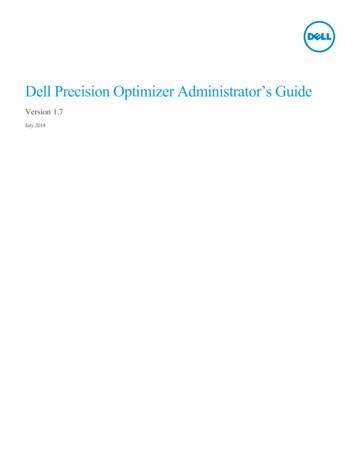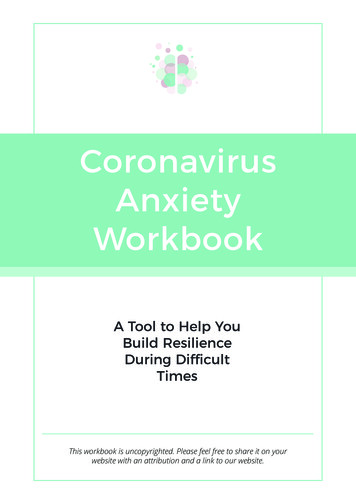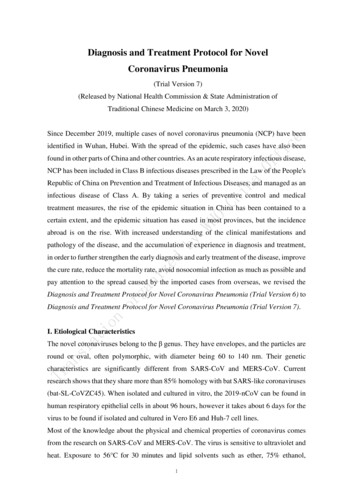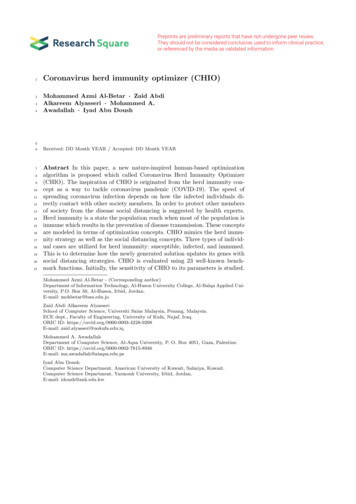
Transcription
Noname manuscript No.(will be inserted by the editor)1234Coronavirus herd immunity optimizer (CHIO)Mohammed Azmi Al-Betar · Zaid AbdiAlkareem Alyasseri · Mohammed A.Awadallah · Iyad Abu Doush56789101112131415161718192021Received: DD Month YEAR / Accepted: DD Month YEARAbstract In this paper, a new nature-inspired human-based optimizationalgorithm is proposed which called Coronavirus Herd Immunity Optimizer(CHIO). The inspiration of CHIO is originated from the herd immunity concept as a way to tackle coronavirus pandemic (COVID-19). The speed ofspreading coronavirus infection depends on how the infected individuals directly contact with other society members. In order to protect other membersof society from the disease social distancing is suggested by health experts.Herd immunity is a state the population reach when most of the population isimmune which results in the prevention of disease transmission. These conceptsare modeled in terms of optimization concepts. CHIO mimics the herd immunity strategy as well as the social distancing concepts. Three types of individual cases are utilized for herd immunity: susceptible, infected, and immuned.This is to determine how the newly generated solution updates its genes withsocial distancing strategies. CHIO is evaluated using 23 well-known benchmark functions. Initially, the sensitivity of CHIO to its parameters is studied.Mohammed Azmi Al-Betar - (Corresponding author)Department of Information Technology, Al-Huson University College, Al-Balqa Applied University, P.O. Box 50, Al-Huson, Irbid, Jordan.E-mail: mohbetar@bau.edu.joZaid Abdi Alkareem AlyasseriSchool of Computer Science, Universiti Sains Malaysia, Penang, Malaysia.ECE dept., Faculty of Engineering, University of Kufa, Najaf, Iraq.ORIC ID: https://orcid.org/0000-0003-4228-9298E-mail: zaid.alyasseri@uokufa.edu.iqMohammed A. AwadallahDepartment of Computer Science, Al-Aqsa University, P. O. Box 4051, Gaza, Palestine.ORIC ID: https://orcid.org/0000-0002-7815-8946E-mail: ma.awadallah@alaqsa.edu.psIyad Abu DoushComputer Science Department, American University of Kuwait, Salmiya, Kuwait.Computer Science Department, Yarmouk University, Irbid, Jordan.E-mail: idoush@auk.edu.kw
2222324252627Mohammed Azmi Al-Betar et al.Thereafter, the comparative evaluation against seven state-of-the-art methodsis conducted. The comparative analysis verifies that CHIO is able to yieldvery competitive results compared to those obtained by other well-establishedmethods. In conclusion, CHIO is a very powerful optimization algorithm thatcan be used to tackle many optimization problems across a wide variety ofoptimization domains.29Keywords Coronavirus · COVID-19 · herd immunity · Optimization ·Nature inspired · Metaheuristic301 49505152535455565758596061626364Optimization is the process of finding the best configurations of some entitiesfollowing limited resources respecting predefined constraints [55]. The optimization process can be utilized in several research domains such as health,engineering, mathematics, economics, linguistics, and science to optimize (minimize or maximize) their objective [43]. In order to tackle optimization problems, two types of optimization methods emerge deterministic-based and approximationbased [51]. Traditionally, deterministic-based methods are utilized to tacklesome optimization problems with small dimensions and less complexity. Although they can find an exact solution for the optimization problem, theysuffer from some dilemmas such as they cannot be used to tackle the NP-hardproblems; they require heavy mathematical derivation especially for gradientbased techniques; they can easily be stuck in a local optima [42]. Thus, theyare inefficient in tackling real-world problems. Consequently, the optimizationresearch communities tend their attentions to utilize approximation methodsfor their optimization problems.Approximation methods have stochastic components to intelligently overcome the deterministic-based dilemmas. The traditional approximation-basedmethods were heuristic-based in which the optimization problem is constructively tackled element by element until a complete solution is reached [8].Heuristic methods are problem-specific where each optimization problem hasits own heuristic methods, for example, graph coloring problems use saturationalgorithm heuristic methods [45]. The heuristic-based approaches althoughthey can easily find a solution for the optimization problem, the quality of theconstructed solution is not unfortunately respected. The ultimate objectiveof tackling optimization problem is not only to find any solution, but also tofind a “good enough” solution. Therefore, the emergence of metaheuristic algorithms as an efficient approximation-based method acquired high attentiondue to its superior advantages.Metaheuristic-based approaches provide a general optimization frameworkthat can iteratively improve the current solution(s) using intelligent knowledgeacquisition operators with stochastic features controlled by tuned parameters until an optimal solution is reached [43]. The operators of the powerfulmetaheuristic algorithms can efficiently explore several regions in the problemsearch space as well as exploit the accumulative knowledge acquired during the
Coronavirus herd immunity optimizer 1081091103search process. Exploitation and exploration are contradictory, and achievingthe right balance between them during the search is the main algorithmicchallenge. The main advantages of these metaheuristic algorithms are [42]:i) Their simplicity to be adapted for a wide range of optimization problemswith very small tweaking. They are dealt with the optimization problem asblack-box mathematically formulated in terms of objective function and solution representation in which the problem-specific knowledge is not necessarilydeeply studied. ii) They do not require mathematical-derivative informationin the initial search. iii) They can easily escape the local optima using theirstochastic-based components. Interestingly, the most metaheuristic-based algorithms are originated from nature-inspired phenomena which can be categorized into four classes: evolutionary-based, swarm-based, physical-based,and human-based algorithms [40, 14]. These categories of metaheuristic-basedalgorithms are summarized in Table 1.Evolutionary Algorithms (EA) are naturally inspired from the evolutionprocess initiated with a population of random individuals. Generation aftergeneration, the gens of the parent individuals in the population are recombined and mutated to come up with offspring individuals which are adoptedbased on the survival-of-the-fittest principle in the natural selection scheme.The firstly developed EA is genetic algorithm (GA) proposed by John HenryHolland in 1960 to utilize the Darwinian principle of natural evolution [21].Swarm-based algorithms are normally inspired by the social behavior of animalswarms. The main merit of such class is their ability to collaboratively survive.The earlier and considered the first swarm-based algorithms is Particle SwarmOptimization (PSO) [28] which imitates the bird flocking social behavior. Theparticles (solutions) flies around their environment (search space ) searchingfor the optimal position (global best). During the flying process, the best positions (local best) in the path to the optimal position is recorded. Other baseswarm-based optimizer are Ant Colony Optimization (ACO) [10], ArtificialBee Colony (ABC) [26] and many others summarized in Table 1. Physicalbased algorithms are inspired by the physical laws appeared in the universe.The base algorithm of such category is Simulated Annealing (SA) which imitates thermodynamics process when the metals are cooled and annealed [29].Other Physical-based algorithms are summarized in Table 1. Finally, humanbased algorithm stimulates the human’s behavior, lifestyle or perception. Thebase method of such class is Harmony Search Algorithm (HSA) in which agroup of JAZZ musicians plays the notes of their instruments, practice afterpractice until a pleasing harmony (optimal solution) is obtained [18]. Otherpopular human-based algorithms are Fireworks algorithm (FA) [54] and manyothers as reported in Table 1.Apparently, there are a plethora of nature-inspired algorithms which can beefficiently used for a wide range of optimization problems. However, accordingto the No Free Lunch (NFL) Theorem, the optimization algorithm cannotwork efficiently for all types of optimization problems [59]. Furthermore, mostdeterministic or even heuristic optimization is not workable for problems withnon-linearity and multi-modality. Therefore, the tremendous developments of
4Mohammed Azmi Al-Betar et al.Table 1: Nurtured-inspired Optimization 6127128129130131132133Nurtured-inspired AlgorithmsGenetic Algorithm (GA) [21], Evolution Strategy (ES) [6], Genetic Programming (GP) [30], and Biogeography-Based Optimizer (BBO) [53]Swarm-basedParticle swarm optimization (PSO) [28], Ant colony optimization (ACO)[10], Cuckoo search (CS) [62], Bat algorithm (BA) [64], Ant Lion Optimizer (ALO) [35], Butterfly optimization algorithm (BOA) [3], Dragonflyalgorithm (DA) [37], fruit fly optimization algorithm (FOA) [44], Greywolf optimizer (GWO) [42], Krill herd algorithm (KHA) [17], Red deer algorithm (RDA) [13], Bird mating optimizer (BMO) [4], Flower pollinationalgorithm (FPA) [61], Monarch butterfly optimization (MBO) [56], Mothflame optimization algorithm (MFO) [36], whale optimization algorithm(WOA) [40], Firefly algorithm (FA) [63], Artifical bee colony (ABC) [26],Salp Swarm Algorithm (SSA) [39], Harris hawks optimization (HHO) [24],and crow search algorithm (CSA) [5]Physical-basedSimulated annealing (SA) [29], Multi-verse optimizer (MVO) [41],Sine cosine algorithm (SCA) [38], Water cycle algorithm (WCA) [12],Electromagnetism-like mechanism (EM) [7], Gravitational search algorithm (GSA) [48], Charged system search (CSS) [27], big bang–big crunch(BBBC) [11], and Henry gas solubility optimization (HGSO) [22]Human-BasedFireworks algorithm (FA) [54], Harmony Search Algorithm (HSA) [18],Wisdom of Artificial Crowds (WAC) [60], β-Hill Climbing (βHC) [1], Tabusearch (TS) [20], Group search optimizer (GSO) [23], Interior search algorithm (ISA) [16], Seeker optimization algorithm [9], Social-based algorithm(SBA) [46], and Mine blast algorithm (MBA) [52]metaheuristic algorithms, although come up with very powerful algorithms,there is still a window to develop other nature-based metaheuristic algorithmswith intelligence characteristics with hope to tackle some complex optimizationproblems powerfully.Nowadays, human-based nature-inspired phenomenon is emerged with asalgorithms such as HSA or βHC achieve pleasing results when compared toother nature-inspired algorithms. This paper proposed a new human-basednature-inspired algorithm Coronavirus Herd Immunity Optimizer (CHIO).Quite recently, the novel 2019 coronavirus evolved and start to spread fromWuhan, China since December 2019. Consequently, the virus spread acrossseveral countries and the World Health Organization (WHO) announces thename of the new contagious disease to be Corona Virus Disease (COVID19) [32]. Herd immunity is proposed as one of the techniques to control theCOVID19 epidemic outbreak [31]. The proposed algorithm relies on the concept of how to best protect the community against the disease by convertingthe majority of the susceptible population which is not infected to becomeimmuned. The phases of herd immunity can be summarized as follows [15,50, 31] firstly, a group of infected people will infect another group of people.Secondly, a large number of infected people will recover and become immunedand a small number of people will die. Finally, after some time the majorityof the population will become protected against the virus.CHIO is modeled in terms of optimization algorithm. Initially, the population individuals are randomly generated and marked as susceptible, and
Coronavirus herd immunity optimizer (CHIO)5153very few members are marked infected. According to the basic reproductionrate (BRr ), the herd immunity of the population is evolved using three rulesof spreading the pandemic following social distancing concepts: susceptible,infected and immuned cases rules. The population members are moved fromsusceptible to infected and from infected to immuned according to herd immunity threshold by adopting the survival-of-the-fittest principle. A few numbersof infected individuals will reach the fatality state. The search is stopped whenthe population reaches the state of herd immunity. In order to verify the efficiency of CHIO, 23 well-known benchmark functions are used for evaluation.The effect of parameters on CHIO performance is initially studied. Then, alternative social distancing strategies are analyzed. Finally, the comparativeevaluation against seven well-regarded methods is provided. The comparativeresults prove the viability of the proposed CHIO. In a nutshell, the new CHIOis a very powerful human-based optimization method that is pregnant withtremendous and successful developments for those who are interested to tackletheir problems using natural-inspired metaheuristic-based algorithms.The remaining sections of this paper are as follows: the proposed CHIOalgorithm and the concepts behind it are introduced in Sect. 2. The performance of the proposed algorithm is evaluated and analyzed in Sect. 3. Finally,the conclusion and some future directions are provided in Sect. 4.1542 Coronavirus herd immunity 7148149150151152163Viruses are normally spread and evolved very quickly among individuals of thepopulation. The health communities normally use a vaccine to build immunityagainst viruses. However, new viruses need a period of time until their vaccinediscovered. In the meanwhile, the health care organizations recommend totreat the virus in one of two ways: i) they isolate the infected individuals fromtheir surrounding communities and isolate all the people they contact. ii) theyuse herd immunity principle to stop pandemics where herd immunity accruedwhen a significant portion of a population is immune resulting in protectingsusceptible individuals.1642.1 170171Viruses can be transmitted biologically and it can be replicated by the amplifying hosts [57]. The novel 2019 coronavirus (2019-nCoV) evolved and startto spread from Wuhan, China since December 2019. Consequently, the virusspread across several countries and the World Health Organization (WHO)announces the name of the new contagious disease to be Corona Virus Disease(COVID-19) [32]. As of 27-March-2020, the number of cases reaches 532,279in 199 countries and territories around the world 1 .1https://www.worldometers.info/coronavirus/
205206207208209210Mohammed Azmi Al-Betar et al.The incubation period of the COVID-19 vary between 2.1 to 11.1 days [32].As to yet, no powerful remedy for COVID-19 is found [32]. The fatality rateof COVID-19 can range between 0.25 to 3.0% [31].Herd immunity means that the population has a large number of peoplethat are protected from being infected (either by vaccination or natural infection) and as a result, the disease will stop from spreading. This happenedbecause more than 60% (i.e., herd immunity threshold) of the population isrecovered from the infection. Herd immunity can affect the epidemic transmission as it can downsize the spread of the infection [50]. Herd immunity isproposed as one of the techniques to control the COVID-19 epidemic outbreak[31]. Note that this approach applies the Darwinian theory about survival ofthe fittest principle.According to the social distancing, the COVID-19 can be transmitted fromhuman-to-human if the person is in close contact to another person (within 1.8meters), by the droplets originated when the infected person sneezes or coughs,or when the person touches his/her mouth, nose or eyes after contacting asurface or object that has the virus on it 2 . The governments followed twoapproaches to control the spread of COVID-19 as still there is no vaccinationavailable the country lock-down or herd immunity 3 .A normal person that is not immuned against the virus is called susceptible. Once infected with the COVID-19 the person becomes a transmittingcase. Now, based on the strength of the person’s immune system s/he can beeither recovered (i.e., immuned) or unfortunately dead. Generally speaking,the elderly immune system is usually weaker than young people because theywould have other diseases such as diabetes, cardiovascular diseases, or cancer.As a result, the person’s age plays an important role in being recovered or not.The average age of the people who are died in Italy is 81 years [49].According to many researchers [15, 50, 31] the main phases of achievingherd immunity are as follows:– A Large number of infected people infect another large group of people.– Most of the infected people are recovered and a small number are dead.– After a while, most of the population will have immunity against the disease.2.2 Herd immunityHerd immunity refers to a situation where enough people in a populationhave immunity to the infection to be able to effectively stop that disease fromspreading. For herd immunity, it does not matter whether the immunity comesfrom vaccination, or from the people who had the disease. The crucial thingis that they are swaminathanaiyar/articleshow/74860557.cms3
Coronavirus herd immunity optimizer (CHIO)2112122137As more people become infected with COVID-19, the disease caused bythe virus, there will be more people who recover and who are then immune tofuture infection.Fig. 1: Herd 228229230Herd immunity is affected by the basic reproduction rate, which representshow many people will be probably infected from the transmitting cases. Thiscan indicate how quickly the disease will spread in the population. Generallyspeaking, when the number of immune cases reaches to be a large percentageof the population (i.e., larger than 60%) the population will be shielded fromhaving more infected cases, such percentage is called herd immunity threshold.The transmitting cases pass the infection and the immune system of theinfected person will preserve an immunological memory of the disease. Thiswill enable the infected person to become immune against that virus in thefuture and thus it will stop the disease from circulation.The coronavirus herd immunity concept is mathematically modeled to develop the proposed optimization algorithm. The algorithm relies on the concept of how to best protect the community against the disease by convertingthe majority of the susceptible population which is not infected to becomeimmuned. As a result, even the remaining susceptible cases will not be infected because the immuned population will not be transmitting the diseaseany more.
8231232233234235236237238239Mohammed Azmi Al-Betar et al.2.3 Population hierarchyThe herd immunity population individuals can be classified into three types [2]:susceptible, infected (or confirmed), and immuned (or recovered) individuals[33]. Figure 2 shows how the three types of individuals are distributed. Thefigure is represented as a tree where the root is the infected individual andthe edges point to the
Department of Information Technology, Al-Huson University College, Al-Balqa Applied Uni-versity, P.O. Box 50, Al-Huson, Irbid, Jordan.
